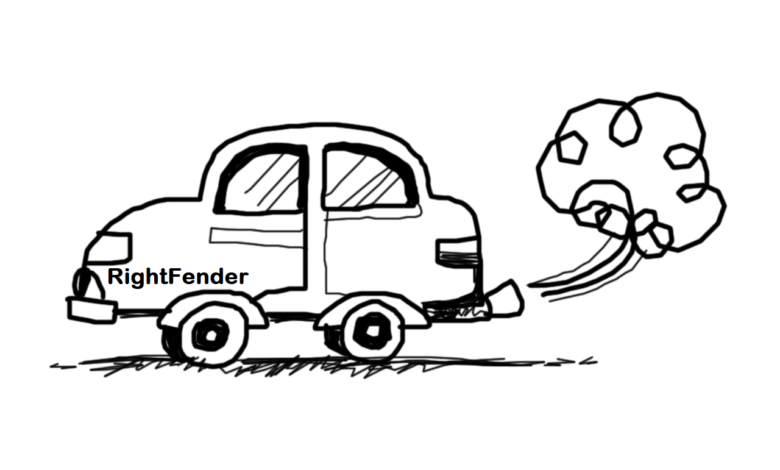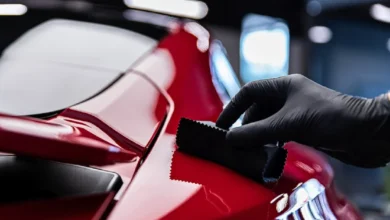
Ever been stuck on the side of the road, smoke pouring out of your tailpipe, and you’re left wondering if your car just decided to star in its own action movie? Yep, that’s probably your exhaust system throwing a tantrum. It’s one of those parts of your car that you don’t think about until you’re stranded, furiously Googling “why is my car so loud?” But fear not – the exhaust system isn’t as mysterious as it seems.
From the exhaust manifold to the muffler, and that elusive oxygen sensor you’ve probably heard about but never really understood, this system works tirelessly to keep your car quiet, eco-friendly, and free from harmful gases. In this article, we’ll break down everything about the exhaust system, so next time you see smoke, you’ll know exactly what’s going on!
Main Components
Let’s start by listing the main components of the exhaust system!
- Exhaust Valve
- Exhaust Manifold
- Catalytic Converter
- Oxygen Sensor
- Tailpipe
- Muffler
- Resonator
For vehicles with turbocharged engines, additional components may include:
- Turbocharger
- Downpipe
- Exhaust Headers
- Flex Pipe
- Exhaust Gas Recirculation (EGR) System
- Diesel Particulate Filter (DPF) (for diesel engines)
1. Exhaust Valve: The Gatekeeper
The exhaust valve is located in the engine’s cylinder head and opens to allow the exhaust gases to escape from the combustion chamber after the power stroke. It’s a critical part of the engine’s overall timing.
Why It’s Important: If the exhaust valve is damaged or not functioning properly, the engine won’t be able to get rid of exhaust gases efficiently. This can lead to backpressure, which can decrease engine performance and increase emissions.
2. Exhaust Manifold: The Starting Point
The exhaust manifold is where the journey begins. Attached directly to the engine’s cylinder head, the manifold collects the exhaust gases from each cylinder and funnels them into one pipe. This component is often made from cast iron or stainless steel and is designed to withstand extreme heat and pressure.
Why It’s Important: The exhaust manifold plays a critical role in channeling the harmful gases away from the engine efficiently. If there’s a leak or crack in the manifold, the gases can escape before being processed, which means your vehicle can lose performance and start making a lot of noise. Ever heard a car sound like a chopper? That’s probably an exhaust manifold issue.
3. Catalytic Converter: The Emission Fighter
Next in line is the catalytic converter – a device that takes all those nasty gases (like carbon monoxide and hydrocarbons) and converts them into less harmful emissions before they leave the car. It uses a combination of precious metals like platinum, palladium, and rhodium to trigger chemical reactions that break down these gases into carbon dioxide, water vapor, and nitrogen.
Why It’s Important: The catalytic converter is the MVP when it comes to reducing harmful emissions. In fact, without it, modern vehicles would struggle to meet environmental regulations. A failing catalytic converter can cause a variety of issues, including poor fuel economy, reduced engine performance, and the dreaded “check engine” light.
4. Oxygen Sensor: The Brainy Little Component
The oxygen sensor is like the exhaust system’s personal detective. It monitors the amount of oxygen in the exhaust gases and sends that information to the engine’s computer. The computer then adjusts the air-fuel mixture to ensure the engine runs as efficiently as possible.
Why It’s Important: A faulty oxygen sensor can lead to poor fuel economy and increased emissions. It can also cause the engine to run “rich” (too much fuel) or “lean” (too little fuel), both of which can damage your engine over time. Plus, no one wants to fail an emissions test because of one tiny sensor.
5. Tailpipe: The Exit Route
The tailpipe is the final piece of the puzzle – the part where the processed gases finally leave your vehicle. It’s usually made of stainless steel or aluminized steel to withstand the corrosive nature of exhaust gases and the elements.
Why It’s Important: A blocked or damaged tailpipe can restrict the flow of exhaust gases, which can negatively impact engine performance and fuel efficiency. Plus, let’s be real, no one wants their car looking like it’s smoking from the rear end.
6. Muffler: The Noise Reducer
The muffler is probably the most well-known part of the exhaust system. Its job is simple: reduce the noise coming from the engine. Inside the muffler are a series of chambers and perforated tubes that help to cancel out sound waves. This is why your car doesn’t sound like a rocket ship (unless you want it to, in which case, you might need a performance exhaust).
Why It’s Important: Without a muffler, your car would be obnoxiously loud, and that’s a quick way to annoy your neighbors. A damaged or worn-out muffler can result in increased noise and a reduction in engine efficiency.
7. Resonator: The Muffler’s Assistant
The resonator works alongside the muffler to further reduce noise. It’s essentially a chamber that “tunes” the sound waves before they reach the muffler. While not every car has a resonator, it’s a crucial part of the exhaust system in vehicles that require extra sound reduction.
Why It’s Important: If your resonator is malfunctioning, your car can still run, but it might sound louder than usual. The resonator doesn’t affect performance as much as other components, but it does help in keeping things quiet.
8. Turbocharger: The Performance Enhancer
The turbocharger isn’t a standard part of every exhaust system, but in high-performance vehicles, it plays a key role. A turbocharger uses the energy from the exhaust gases to spin a turbine, which compresses the air going into the engine. This results in more power and better fuel efficiency.
Why It’s Important: A faulty turbocharger can lead to reduced power and poor fuel economy. Plus, without it, your car just won’t have that extra “oomph” that turbocharged engines are known for.
9. Downpipe: The Turbocharger’s Companion
For vehicles with turbochargers, the downpipe is a critical part of the exhaust system. It connects the turbocharger to the rest of the exhaust piping and is responsible for directing the exhaust gases out of the turbo. A larger, more efficient downpipe can help the turbocharger perform better by reducing backpressure.
Why It’s Important: If the downpipe is restricted or too small, it can choke the turbocharger, reducing the vehicle’s performance. Upgrading the downpipe is a popular modification for enthusiasts looking to boost their turbocharged car’s horsepower and torque.
10. Exhaust Headers: The Performance Boosters
Exhaust headers are high-performance replacements for the exhaust manifold. Unlike the manifold, which collects exhaust gases from multiple cylinders into one shared pipe, headers use individual pipes for each cylinder. This design minimizes backpressure, allowing the engine to expel gases more efficiently and thus produce more power.
Why It’s Important: If you’re looking to improve your vehicle’s horsepower, upgrading to exhaust headers is a good step. Headers help reduce the “exhaust bottleneck” and can lead to noticeable performance gains, especially at higher RPMs. However, installing headers can also make your car louder and more prone to exhaust leaks if not done properly.
11. Flex Pipe: The System’s Flexibility
The flex pipe is exactly what it sounds like – a flexible section of the exhaust system. It allows the exhaust system to move slightly with the engine’s vibrations and movement without cracking or breaking. This flexibility is crucial in preventing damage to other, more rigid parts of the exhaust system.
Why It’s Important: Without a functioning flex pipe, the constant vibrations and movements of the engine could cause stress fractures in the exhaust piping. Over time, this can lead to expensive repairs and potential damage to the entire system. If your flex pipe is damaged, you might notice excessive noise and vibrations when driving.
12. Exhaust Gas Recirculation (EGR): The Emission Reducer
The EGR system helps reduce the amount of nitrogen oxide (NOx) produced by the engine. It does this by recirculating a portion of the exhaust gases back into the combustion chamber, which lowers the combustion temperature and, as a result, reduces NOx emissions.
Why It’s Important: A malfunctioning EGR system can lead to increased emissions and can even cause your engine to knock or ping. Keeping this system in good shape is essential for both performance and environmental reasons.
13. Diesel Particulate Filter (DPF): The Soot Catcher
For diesel engines, the diesel particulate filter (DPF) is an essential component of the exhaust system. Its job is to trap and store soot particles from the exhaust gases, preventing them from being released into the atmosphere. Over time, the DPF will clean itself through a process known as regeneration, where the soot is burned off.
Why It’s Important: A clogged DPF can cause serious issues with your vehicle’s performance, leading to a loss of power, poor fuel efficiency, and even engine damage. Regular maintenance of the DPF is crucial for keeping your diesel vehicle running smoothly and meeting emissions standards.
Exhaust System Axillaries
Here are some axillaries that are very small but without the exhaust system is not completed.
1. Gasket: The Seal of Protection
Gaskets are small but vital components in the exhaust system. They’re used to create airtight seals between different sections of the exhaust piping, preventing gases from leaking out. Gaskets are typically found between the exhaust manifold and the cylinder head, as well as between the catalytic converter and the rest of the exhaust piping.
Why It’s Important: A blown or damaged gasket can lead to exhaust leaks, which can cause a decrease in engine performance, an increase in emissions, and excessive noise. If you notice a hissing or tapping sound coming from your engine, it could be a sign that an exhaust gasket is failing.
2. Heat Shield: The Protector
The heat shield is a simple but vital part of the exhaust system. It’s designed to protect the vehicle’s underbody from the extreme heat generated by the exhaust components.
Why It’s Important: Without a heat shield, the excessive heat from the exhaust system can damage other components of the vehicle, such as the fuel lines or the floor of the car. Over time, this could lead to more serious (and expensive) issues.
3. Exhaust Flange: The Connector
Exhaust flanges are used to connect various parts of the exhaust system, such as the manifold, downpipe, and catalytic converter. These metal connectors are secured with bolts and gaskets to ensure a tight, leak-free fit.
Why It’s Important: A damaged or corroded exhaust flange can cause leaks in the system, leading to increased noise, poor performance, and failed emissions tests. Regularly inspecting the exhaust flanges and replacing them if necessary can help prevent more significant issues down the line.
4. Exhaust Hanger: Holding It All Together
The exhaust hanger is a small, often rubber component that helps support the weight of the exhaust system and keeps it securely attached to the vehicle’s undercarriage. Without these hangers, the exhaust piping would be prone to sagging or dragging on the ground, leading to damage and noise.
Why It’s Important: If an exhaust hanger breaks or comes loose, you might hear rattling noises coming from under your vehicle. Over time, a sagging exhaust system can lead to more severe damage, such as cracks or breaks in the piping.
How It All Works Together
Now that we’ve covered the individual components, let’s talk about how they work together to form a cohesive exhaust system.
When the engine burns fuel, exhaust gases are created as a byproduct of combustion. These gases are collected by the exhaust manifold and funneled into the exhaust pipes. Along the way, the oxygen sensor monitors the gas levels, sending data back to the engine’s computer to adjust the air-fuel mixture for optimal performance.
Next, the gases pass through the catalytic converter, where harmful pollutants like carbon monoxide and hydrocarbons are transformed into less harmful substances like carbon dioxide and water vapor. The muffler and resonator then work together to reduce noise, while the heat shield protects the vehicle from excessive heat.
Finally, the gases exit through the tailpipe, leaving your vehicle quieter, cleaner, and more fuel-efficient.
Common Exhaust System Problems and How to Fix Them
While modern exhaust systems are built to last, they’re not immune to problems. Here are some common issues you might encounter and how to address them:
1. Leaks: Exhaust leaks can occur at any point in the system, from the exhaust manifold to the tailpipe. These leaks can cause increased noise, poor fuel efficiency, and even dangerous carbon monoxide buildup inside the cabin. If you suspect a leak, have your exhaust system inspected and repaired as soon as possible.
2. Clogged Catalytic Converter: Over time, the catalytic converter can become clogged with carbon deposits, reducing its ability to filter emissions. This can lead to poor engine performance, increased emissions, and even engine overheating. Regular maintenance and the use of high-quality fuel can help prevent clogs.
3. Rust and Corrosion: Exhaust systems are constantly exposed to moisture and road salt, making them prone to rust and corrosion. Regularly inspecting your exhaust system for signs of rust and addressing small issues before they become major problems can help prolong the life of your exhaust system.
4. Exhaust Backpressure: Backpressure is a key concept in understanding how the exhaust system affects engine performance. It refers to the pressure that builds up in the exhaust system as the engine expels gases. While too much backpressure can choke the engine and reduce performance, a certain amount of backpressure is necessary to maintain engine efficiency.
Conclusion: Understanding and Maintaining Your Exhaust System
Your vehicle’s exhaust system is more than just a pipe that carries fumes out of the engine. It’s a complex system of components that work together to reduce emissions, improve performance, and keep your car running smoothly. From the exhaust manifold to the tailpipe, each part plays a critical role in maintaining vehicle efficiency and environmental compliance.
Key components like the catalytic converter, oxygen sensor, and muffler are essential for filtering out pollutants, fine-tuning the air-fuel mixture, and keeping noise levels in check. Regular maintenance, including checking for leaks, rust, or clogged components, is vital to prevent potential performance issues and ensure a smooth ride. Whether you’re dealing with a high-performance turbocharged engine or a standard vehicle, understanding the importance of each component helps in maintaining the longevity and health of your exhaust system. Proper upkeep not only enhances vehicle performance but also ensures compliance with stringent emission standards.
We hope you found this article helpful. If you did, be sure to check out our blog for more great content like this.





